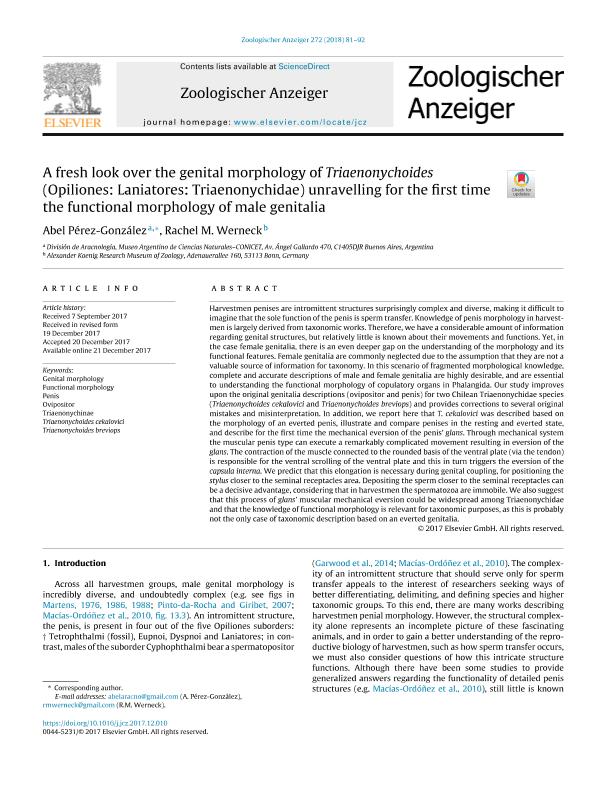Mostrar el registro sencillo del ítem
dc.contributor.author
Pérez González, Abel

dc.contributor.author
Werneck, Rachel M.
dc.date.available
2019-12-27T18:43:38Z
dc.date.issued
2018-01
dc.identifier.citation
Pérez González, Abel; Werneck, Rachel M.; A fresh look over the genital morphology of Triaenonychoides (Opiliones: Laniatores: Triaenonychidae) unravelling for the first time the functional morphology of male genitalia; Elsevier Gmbh; Zoologischer Anzeiger; 272; 1-2018; 81-92
dc.identifier.issn
0044-5231
dc.identifier.uri
http://hdl.handle.net/11336/93139
dc.description.abstract
Harvestmen penises are intromittent structures surprisingly complex and diverse, making it difficult to imagine that the sole function of the penis is sperm transfer. Knowledge of penis morphology in harvestmen is largely derived from taxonomic works. Therefore, we have a considerable amount of information regarding genital structures, but relatively little is known about their movements and functions. Yet, in the case female genitalia, there is an even deeper gap on the understanding of the morphology and its functional features. Female genitalia are commonly neglected due to the assumption that they are not a valuable source of information for taxonomy. In this scenario of fragmented morphological knowledge, complete and accurate descriptions of male and female genitalia are highly desirable, and are essential to understanding the functional morphology of copulatory organs in Phalangida. Our study improves upon the original genitalia descriptions (ovipositor and penis) for two Chilean Triaenonychidae species (Triaenonychoides cekalovici and Triaenonychoides breviops) and provides corrections to several original mistakes and misinterpretation. In addition, we report here that T. cekalovici was described based on the morphology of an everted penis, illustrate and compare penises in the resting and everted state, and describe for the first time the mechanical eversion of the penis’ glans. Through mechanical system the muscular penis type can execute a remarkably complicated movement resulting in eversion of the glans. The contraction of the muscle connected to the rounded basis of the ventral plate (via the tendon) is responsible for the ventral scrolling of the ventral plate and this in turn triggers the eversion of the capsula interna. We predict that this elongation is necessary during genital coupling, for positioning the stylus closer to the seminal receptacles area. Depositing the sperm closer to the seminal receptacles can be a decisive advantage, considering that in harvestmen the spermatozoa are immobile. We also suggest that this process of glans’ muscular mechanical eversion could be widespread among Triaenonychidae and that the knowledge of functional morphology is relevant for taxonomic purposes, as this is probably not the only case of taxonomic description based on an everted genitalia.
dc.format
application/pdf
dc.language.iso
eng
dc.publisher
Elsevier Gmbh

dc.rights
info:eu-repo/semantics/openAccess
dc.rights.uri
https://creativecommons.org/licenses/by-nc-sa/2.5/ar/
dc.subject
FUNCTIONAL MORPHOLOGY
dc.subject
GENITAL MORPHOLOGY
dc.subject
OVIPOSITOR
dc.subject
PENIS
dc.subject
TRIAENONYCHINAE
dc.subject
TRIAENONYCHOIDES BREVIOPS
dc.subject
TRIAENONYCHOIDES CEKALOVICI
dc.subject.classification
Zoología, Ornitología, Entomología, Etología

dc.subject.classification
Ciencias Biológicas

dc.subject.classification
CIENCIAS NATURALES Y EXACTAS

dc.title
A fresh look over the genital morphology of Triaenonychoides (Opiliones: Laniatores: Triaenonychidae) unravelling for the first time the functional morphology of male genitalia
dc.type
info:eu-repo/semantics/article
dc.type
info:ar-repo/semantics/artículo
dc.type
info:eu-repo/semantics/publishedVersion
dc.date.updated
2019-10-16T19:30:08Z
dc.journal.volume
272
dc.journal.pagination
81-92
dc.journal.pais
Alemania

dc.description.fil
Fil: Pérez González, Abel. Consejo Nacional de Investigaciones Científicas y Técnicas. Oficina de Coordinación Administrativa Parque Centenario. Museo Argentino de Ciencias Naturales “Bernardino Rivadavia”; Argentina
dc.description.fil
Fil: Werneck, Rachel M.. Alexander Koenig Research Museum Of Zoology; Alemania
dc.journal.title
Zoologischer Anzeiger

dc.relation.alternativeid
info:eu-repo/semantics/altIdentifier/url/https://www.sciencedirect.com/science/article/pii/S0044523117301249
dc.relation.alternativeid
info:eu-repo/semantics/altIdentifier/doi/http://dx.doi.org/10.1016/j.jcz.2017.12.010
Archivos asociados
